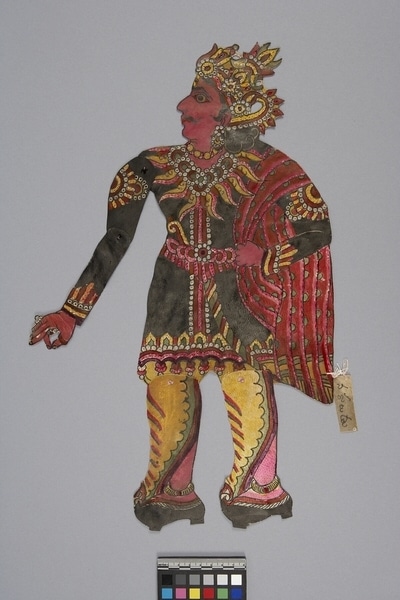Shadow Puppet Item Number: Ef220 from the MOA: University of British Columbia

Description
A shadow puppet of leather cut out representing a male figure, nobly adorned. Aniline dyes have blocked the normal transparency. Dyes include black, red, purple, pink, green, and yellow. Three limbs move. The one moveable arm is jointed at the shoulder and elbow. Costume and jewelry include a series of punched out designs. Has pink skin. Wearing an elaborate yellow, red, and green headdress. Black overcoat has yellow, red, and green accents with a pink, and red belt. Red scarf is decorated with green dots, and edged with pink. Yellow, green, red, purple, and pink pants with black shoes.
History Of Use
Puppetry, particularly shadow puppets, is an ancient dramatic form in India mentioned in the Buddhist Jataka Tales of the 3rd century B.C.E. Nowadays modern forms of entertainment, such as the Hindi film industry, have rendered them extinct except for some rural areas in the states of Orissa, Kerala, Andhra Pradesh, and Tamil Nadu. The Andhra Pradesh/Karnataka shadow puppet tradition, compared to the few remaining troupes, are the most extensive and dramatic. Probably originally Maharashtran and maintained by dynasties, such as the Vijaynagars of the 13th and 14th centuries, it now survives as presented by Marathi-speaking puppeteers, commonly called raoji. These are the largest in size of the Indian shadow puppets.
Iconographic Meaning
Possibly represents Dasarala, father of Rama.
Item History
- Made in Waltair, Andhra Pradesh, India between 1880 and 1930
- Collected during 1976
- Owned by Stephen Inglis before December 2, 1977
- Received from Museum of Anthropology Donations Fund (Funding source) and Stephen Inglis (Seller) on December 2, 1977
What
Who
- Culture
- South India
- Previous Owner
- Stephen Inglis
- Received from
- Museum of Anthropology Donations Fund (Funding source) and Stephen Inglis (Seller)
Where
- Holding Institution
- MOA: University of British Columbia
- Made in
- Waltair, Andhra Pradesh, India
When
- Creation Date
- between 1880 and 1930
- Collection Date
- during 1976
- Ownership Date
- before December 2, 1977
- Acquisition Date
- on December 2, 1977
Other
- Condition
- good
- Accession Number
- 0411/0185